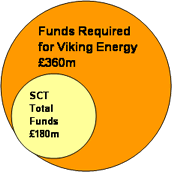Viking Energy wind farm finances
Costs
Viking Energy estimate the project cost, in May 2009, at about £800m (up £200m from the previous month!). However the true cost could be greatly in excess of this.
Even taking this £800m figure as an initial guide, Viking Energy Ltd (a company 90% owned by Shetland Charitable Trust) share of the project is about £360m. The remaining £40m from four private shareholders. How these individuals, who include Viking Energy project officer David Thomson, plan to raise with £10m each remains to be seen.
Shetland Charitable Trust has invested funds of around £180m (at October 2009). Much of this is money currently invested on equity markets and subject to rapid change out with control of Charitable Trust. Current return target and annual spend is about £12m a year.
A proposed initial stake of 20% from these community trust funds would be £72m, however, a down payment as high as £81m has been mentioned by a Charitable Trust trustee. This represents about 50% of total funds. It is also equivalent to over 6 years planned charitable expenditure. Nobody is saying what happens to current charitable spending whilst the project is in construction phase.
 Total project share of community funds represents nearly 200% of funds
available, i.e. more than double what we actually have available ...
Total project share of community funds represents nearly 200% of funds
available, i.e. more than double what we actually have available ...
For the first time in its history the Charitable Trust would move from surplus into debt.
In February 2009 Viking Energy consultant, Avayl, gave an estimate of cost per turbine of £1.35m per MW, which places the project in the region of £729m, £129m more than Viking Energy's then headline total of £600m. A report to the Scottish Government estimates costs per MW at around £1.4m per MW installed. This gives around £756m cost for a 540MW wind farm. Clearly Viking Energy have played fast and loose with real costs in the past, their current £800m figure could still be seen as a guess, because no-one has ever built a wind farm of this size, on this terrain, in this area before.
Many large capital projects in Shetland run 20 - 30% over budget. The Viking Energy wind farm may be no exception to this.
Sustainable Shetland considers this wind farm a reckless gamble with community funds, at the expense of the Shetland environment.
Profit
Viking Energy have claimed various profit figures throughout the project. The main point in all these figures is to imply the project is a sure fire, guaranteed success. Unfortunately, Viking Energy do not know the final build cost, they do not know the cost of electricity transmission, they do not know the price they will get for this electricity. In short these figures are just models, or to put it more bluntly, pure speculation. The key cost element, the cost of transmission can be changed by national government. Viking Energy are lobbying hard to get the transmission charge subsidised to enable the project to make a profit. On current charging mechanisms the project is not profitable. The subsidised transmission charge would be met by... increases in consumer charges! That's you and me. The trouble with subsidies, being government controlled, they can be given, and they can be taken away. Laws can be changed. Governments come and go. The basis for this project is subsidies by way of renewable obligation certificates, subsidised transmission charges and a hope that none of this will ever change during the 25 year life of the wind farm.
A recent Advertising Standards Authority ruling told Viking Energy that they cannot continue to claim a specific value of profit or community return without actually substantiating the claims with evidence such as contracts for sale of electricity
Charity payments for landowners?
There is a fear that offers of rent and payments to landowners, in advance of any actual revenue from the project, effectively means that some of the money these individuals receive, are paid from the funds of the Shetland Charitable Trust.
So whilst some individuals may be cashing in on this project, the people and organisations of Shetland who rely on Charitable Trust funding may find there is much less to go around than before the Viking Energy project appeared. This situation could last for 8 to 10 years after construction begins, and before the project generates actual revenue. Far from being a bounty for Shetland, it could be austere times ahead for the many, to finance this gamble for the benefit of a few.
Since December 2008 Viking Energy directors, and Charitable Trust staff, have made comments which suggest that the project cannot be afforded, and that beyond planning consent, it was unlikely that Shetland Charitable Trust could afford the risk, or expense of funding the project.
On this basis the claim that the project has community involvement is very suspect. If the planning application to Scottish ministers is made on this basis, it will be a deliberate distortion of the truth if the plan is to sell all or a substantial stake in Viking Energy to the highest bidder. Whether or not anyone actually wants Viking Energy Ltd. beyond its Trojan horse services is debatable.
